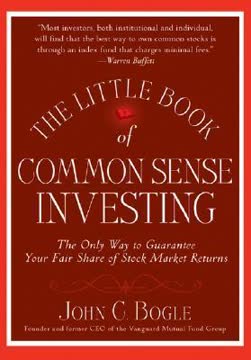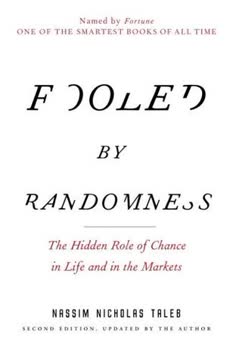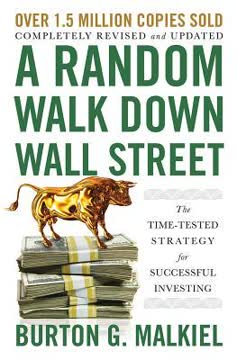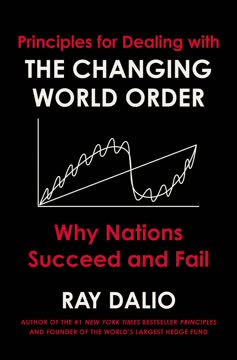نکات کلیدی
1. پذیرش سرمایهگذاری غیرفعال برای بازدهی برتر و آرامش ذهن
"با سرمایهگذاری دورهای در یک صندوق شاخص، سرمایهگذار ناآگاه میتواند در واقع از بیشتر حرفهایهای سرمایهگذاری پیشی بگیرد."
سرمایهگذاری غیرفعال برنده است. دههها تحقیق دانشگاهی و شواهد دنیای واقعی نشان میدهد که سرمایهگذاری غیرفعال به طور مداوم از استراتژیهای مدیریت فعال پیشی میگیرد. این رویکرد شامل سرمایهگذاری در صندوقهای شاخص کمهزینه یا صندوقهای قابل معامله در بورس (ETF) است که شاخصهای بازار گسترده را دنبال میکنند، به جای تلاش برای انتخاب سهام فردی یا زمانبندی بازار.
مزایای کلیدی سرمایهگذاری غیرفعال:
- هزینههای کمتر (هزینههای مدیریت، هزینههای معامله)
- کارایی مالیاتی بیشتر
- کاهش تصمیمگیری احساسی
- زمان بیشتر برای تمرکز بر جنبههای دیگر زندگی
با پذیرش سرمایهگذاری غیرفعال، سرمایهگذاران میتوانند بازدهی بازار را به دست آورند و از مشکلات مدیریت فعال مانند هزینههای بالا، معاملات مکرر و عملکرد ضعیف اجتناب کنند. این استراتژی با توصیههای وارن بافت همسو است و مسیر ساده و موثری برای انباشت ثروت بلندمدت فراهم میکند.
2. درک کارایی بازار و بیفایده بودن مدیریت فعال
"مهمترین ویژگی برای یک سرمایهگذار، خلق و خو است، نه هوش."
بازارها کارآمد هستند. فرضیه بازار کارآمد بیان میکند که قیمتهای اوراق بهادار تمام اطلاعات موجود را منعکس میکنند، و این امر برای مدیران فعال بسیار دشوار است که به طور مداوم از بازار پیشی بگیرند پس از محاسبه هزینهها و مخارج. این مفهوم پایه و اساس منطقی برای سرمایهگذاری غیرفعال است.
شواهد علیه مدیریت فعال:
- عدم عملکرد پایدار
- هزینههای بالا بازدهی را کاهش میدهد
- دشواری در زمانبندی بازار
- تعصبات احساسی منجر به تصمیمگیری ضعیف میشود
درک کارایی بازار به سرمایهگذاران کمک میکند تا در برابر وسوسه دنبال کردن سهام "داغ" یا پیشبینیهای بازار مقاومت کنند. در عوض، این امر یک رویکرد منظم و بلندمدت را تشویق میکند که بر دستیابی به بازدهی بازار از طریق تنوع گسترده و وسایل سرمایهگذاری کمهزینه تمرکز دارد.
3. توسعه یک برنامه مالی جامع متناسب با اهداف شما
"کسانی که برنامهریزی نمیکنند، برای شکست برنامهریزی میکنند."
برنامهریزی جامع حیاتی است. یک برنامه مالی خوب طراحی شده فراتر از سرمایهگذاریها میرود و شامل برنامهریزی املاک، استراتژیهای مالیاتی، مدیریت ریسک و نیازهای بیمه میشود. این رویکرد جامع تضمین میکند که تمام جنبههای زندگی مالی شما به طور هماهنگ برای دستیابی به اهداف شما کار میکنند.
اجزای کلیدی یک برنامه مالی جامع:
- اهداف مالی واضح و قابل اندازهگیری
- استراتژی تخصیص دارایی
- مدیریت ریسک (بیمه)
- برنامهریزی املاک
- استراتژیهای بهینهسازی مالیاتی
- بازبینی و تنظیم منظم
با توسعه یک برنامه مالی متناسب، سرمایهگذاران میتوانند تصمیمات آگاهانهای بگیرند که با اهداف بلندمدت، تحمل ریسک و شرایط منحصر به فرد آنها همسو باشد. این رویکرد ساختاریافته به حفظ انضباط در طول نوسانات بازار کمک میکند و نقشه راهی برای موفقیت مالی فراهم میکند.
4. تعیین تخصیص دارایی بهینه بر اساس تحمل ریسک
"بیش از توانایی، تمایل یا نیاز خود ریسک نکنید."
تعادل ریسک و بازده. تخصیص دارایی، تقسیم پرتفوی شما بین سهام، اوراق قرضه و سایر کلاسهای دارایی، عامل اصلی بازدهی و ریسک سرمایهگذاری بلندمدت است. تعیین ترکیب مناسب به توانایی، تمایل و نیاز منحصر به فرد شما برای پذیرش ریسک بستگی دارد.
عوامل مؤثر بر تخصیص دارایی:
- افق زمانی
- اهداف مالی
- ثبات درآمد
- تحمل ریسک
- وضعیت مالی فعلی
یک استراتژی تخصیص دارایی خوب طراحی شده به سرمایهگذاران کمک میکند تا تعادل مناسبی بین پتانسیل رشد و حفاظت از نزول برقرار کنند. این امر چارچوبی برای تصمیمگیریهای سرمایهگذاری فراهم میکند و به حفظ انضباط در طول نوسانات بازار کمک میکند، و احتمال دستیابی به اهداف مالی بلندمدت را افزایش میدهد.
5. تنوعبخشی جهانی در کلاسهای دارایی متعدد برای موفقیت بلندمدت
"تنوعبخشی همیشه کار میکند؛ گاهی نتایج را دوست خواهید داشت و گاهی نه."
پخش ریسکها. تنوعبخشی جهانی در کلاسهای دارایی متعدد ریسک پرتفوی را کاهش میدهد و بازدهی بلندمدت را افزایش میدهد. با سرمایهگذاری در ترکیبی از سهام داخلی و بینالمللی، اوراق قرضه، املاک و مستغلات و کالاها، سرمایهگذاران میتوانند بازدهی از بخشهای مختلف بازار را به دست آورند و در عین حال تأثیر عملکرد ضعیف در هر منطقه خاص را به حداقل برسانند.
مزایای تنوعبخشی جهانی:
- کاهش نوسانات پرتفوی
- دسترسی به فرصتهای رشد در سراسر جهان
- حفاظت در برابر ریسکهای خاص کشور
- پتانسیل بازدهی بالاتر با توجه به ریسک
پذیرش تنوعبخشی جهانی به سرمایهگذاران کمک میکند تا از مشکلات تعصب به کشور خود و تمرکز بیش از حد در داراییهای آشنا اجتناب کنند. این امر ساختار پرتفوی قویتری را فراهم میکند که قادر به تحمل شرایط اقتصادی و بازار مختلف است.
6. اجرای استراتژیهای بازبینی منظم و مدیریت مالیاتی
"استراتژی برای ثروتمند شدن کاملاً متفاوت از استراتژی برای ثروتمند ماندن است."
حفظ تخصیص هدف. بازبینی منظم پرتفوی و مدیریت مالیاتی کارآمد برای موفقیت سرمایهگذاری بلندمدت حیاتی است. بازبینی شامل تنظیم دورهای پرتفوی شما به تخصیص دارایی هدف آن است، در حالی که استراتژیهای مدیریت مالیاتی به حداقل رساندن تأثیر مالیات بر بازدهی سرمایهگذاری میپردازند.
تکنیکهای کلیدی بازبینی و مدیریت مالیاتی:
- بازبینی دورهای پرتفوی (مثلاً سالانه یا زمانی که تخصیصها به طور قابل توجهی تغییر میکنند)
- برداشت زیان مالیاتی
- بهینهسازی مکان دارایی (قرار دادن سرمایهگذاریها در حسابهای مالیاتی کارآمدتر)
- زمانبندی دقیق خرید و فروش برای به حداقل رساندن تأثیر مالیاتی
اجرای این استراتژیها به حفظ پروفایل ریسک مطلوب شما کمک میکند، سود از داراییهای با عملکرد بهتر را به دست میآورد و بازدهی پس از مالیات را به حداکثر میرساند. اجرای منظم این تکنیکها میتواند به طور قابل توجهی عملکرد پرتفوی بلندمدت را بهبود بخشد.
7. تمرکز بر "سنگهای بزرگ" در زندگی، نه فقط بازدهی سرمایهگذاری
"حقیقتی که این تصویر به ما میآموزد این است که اگر سنگهای بزرگ را ابتدا قرار ندهید، هرگز نمیتوانید آنها را جا دهید."
اولویتبندی آنچه واقعاً مهم است. در حالی که دستیابی به اهداف مالی مهم است، حفظ دیدگاه و تمرکز بر جنبههای واقعاً معنادار زندگی حیاتی است. سرمایهگذاری غیرفعال زمان و انرژی ذهنی را آزاد میکند که میتواند به سمت خانواده، رشد شخصی، مشارکت در جامعه و سایر "سنگهای بزرگ" که رضایت زندگی را فراهم میکنند، هدایت شود.
مزایای یک رویکرد متعادل:
- کاهش استرس و اضطراب درباره سرمایهگذاریها
- زمان بیشتر برای روابط و فعالیتهای معنادار
- بهبود رضایت کلی از زندگی
- همسویی بهتر بین اهداف مالی و ارزشهای شخصی
با پذیرش استراتژی سرمایهگذاری غیرفعال و حفظ یک برنامه مالی خوب طراحی شده، سرمایهگذاران میتوانند به اهداف مالی خود دست یابند و در عین حال مهمترین جنبههای زندگی خود را اولویتبندی کنند. این رویکرد متعادل به رفاه کلی بیشتر و یک سفر زندگی رضایتبخشتر منجر میشود.
آخرین بهروزرسانی::
FAQ
1. What is "Think, Act, and Invest Like Warren Buffett" by Larry E. Swedroe about?
- Practical Investment Guide: The book distills Warren Buffett’s investment philosophy into actionable steps for everyday investors, focusing on evidence-based, prudent strategies.
- Passive vs. Active Investing: It advocates for passive investing through index funds, explaining why this approach outperforms most active strategies.
- Behavioral Insights: Swedroe explores the psychological pitfalls that derail investors and offers advice on developing the right temperament and discipline.
- Comprehensive Financial Planning: The book extends beyond investing, emphasizing the importance of integrated financial, estate, tax, and risk management planning.
- Life Lessons: Swedroe connects investment success to broader life satisfaction, urging readers to focus on what truly matters—“the big rocks” in life.
2. Why should I read "Think, Act, and Invest Like Warren Buffett" by Larry E. Swedroe?
- Buffett’s Wisdom Simplified: The book translates Warren Buffett’s complex investment principles into simple, actionable advice for non-experts.
- Evidence-Based Approach: Swedroe relies on decades of academic research and real-world data, not just opinions or anecdotes.
- Avoiding Common Mistakes: Readers learn how to sidestep the costly errors most investors make, such as market timing and chasing forecasts.
- Holistic Financial Guidance: It covers not just investing, but also planning for taxes, insurance, estate, and life goals.
- Improved Quality of Life: By adopting these strategies, readers can spend less time worrying about markets and more time on meaningful pursuits.
3. What are the key takeaways from "Think, Act, and Invest Like Warren Buffett"?
- Passive Investing Wins: Most investors, including professionals, underperform the market; low-cost index funds are the best choice for the majority.
- Ignore Market Noise: Forecasts and market timing are distractions—Buffett himself ignores them, and so should you.
- Discipline and Planning: Success comes from having a written investment plan and sticking to it, especially during market turmoil.
- Diversification is Essential: Broad diversification across asset classes is the only “free lunch” in investing.
- Integrated Life Planning: Financial success is about more than returns; it’s about aligning your investments with your life’s priorities.
4. How does Larry E. Swedroe define and recommend passive investing in "Think, Act, and Invest Like Warren Buffett"?
- Index Funds as Core: Swedroe recommends investing in low-cost index funds or passively managed funds, which track broad market segments.
- Avoiding Active Management: He explains that active strategies—stock picking and market timing—rarely outperform after costs and taxes.
- Evidence-Based Rationale: The book cites research showing that passive investors consistently achieve better net results than active investors.
- Simplicity and Discipline: Passive investing is simple to implement and requires the discipline to stay the course, regardless of market conditions.
- Market Returns, Not Average: Passive investing delivers market returns, which are superior to the average investor’s results due to lower costs and better behavior.
5. What are the main behavioral mistakes investors make, according to "Think, Act, and Invest Like Warren Buffett"?
- Market Timing Temptation: Investors often try to time the market, buying high and selling low, which erodes returns.
- Overreacting to News: Many react emotionally to bad news, not realizing that markets already price in expectations.
- Stage-One Thinking: Swedroe warns against focusing only on immediate crises without considering long-term responses and solutions.
- Ignoring Written Plans: Investors frequently abandon their investment plans during periods of fear or greed.
- Seeking Forecasts: Relying on market predictions or “expert” opinions leads to poor decisions, as even professionals can’t forecast accurately.
6. How does "Think, Act, and Invest Like Warren Buffett" recommend building a well-diversified portfolio?
- Asset Class Diversification: Swedroe advocates spreading investments across U.S. and international stocks, small-cap and value stocks, bonds, real estate, and commodities.
- Risk Factor Exposure: The book emphasizes diversifying by risk factors (size, value, geography) to reduce volatility and improve returns.
- Use of Mutual Funds/ETFs: He recommends mutual funds and ETFs for effective diversification, as owning individual securities increases uncompensated risk.
- Rebalancing: Regularly rebalance the portfolio to maintain target allocations and risk levels.
- Avoiding Concentration: Don’t overinvest in familiar companies or your employer’s stock, as this increases risk without additional expected return.
7. What is the role of financial planning and an Investment Policy Statement (IPS) in Swedroe’s approach?
- Written Roadmap: An IPS serves as a contract with yourself, outlining objectives, asset allocation, and rebalancing rules.
- Living Document: The plan should be reviewed and updated as life circumstances or market assumptions change.
- Integrated Planning: Swedroe stresses integrating investment planning with estate, tax, and risk management (insurance) planning.
- Contingency Planning: The IPS should include actions to take if the portfolio underperforms, such as reducing spending or delaying retirement.
- Goal Tracking: Clearly defined goals and regular progress reviews help maintain discipline and make necessary adjustments.
8. How does "Think, Act, and Invest Like Warren Buffett" address risk and asset allocation decisions?
- Ability, Willingness, Need: Swedroe recommends assessing risk based on your ability (time horizon, job stability), willingness (emotional tolerance), and need (required return) to take risk.
- Human Capital Consideration: Factor in the stability and correlation of your future income (labor capital) when deciding asset allocation.
- Role of Bonds: Bonds should anchor the portfolio, reducing overall risk; only take risks with stocks.
- Liquidity Needs: Maintain a cash reserve for emergencies, typically six months of expenses.
- Avoiding Uncompensated Risk: Only take risks for which you are compensated; diversify away risks like individual stock or sector exposure.
9. What does Swedroe say about hiring a financial advisor versus being a do-it-yourself investor?
- Self-Assessment: He provides five questions to determine if you have the knowledge, skills, and temperament to manage your own investments.
- Value of Advisors: Good advisors add value through integrated planning, discipline, education, and freeing up your time for more important pursuits.
- Fiduciary Standard: Only work with advisors who adhere to a fiduciary standard, putting your interests first and avoiding commission-based compensation.
- Evidence-Based Advice: Choose advisors who base recommendations on peer-reviewed research, not opinions or sales pitches.
- Due Diligence: Perform thorough research on advisors, including checking credentials, compensation structure, and client references.
10. What are the "30 Rules of Prudent Investing" outlined in "Think, Act, and Invest Like Warren Buffett"?
- Risk Management: Don’t take more risk than you can handle or need; understand all risks before investing.
- Simplicity and Diversification: Avoid complex products, diversify broadly, and stick to low-cost, passive investments.
- Discipline and Planning: Have a written plan, rebalance, and integrate investment with estate and insurance planning.
- Skepticism of Forecasts: Ignore market predictions and “this time is different” thinking; base decisions on evidence.
- Advisor Selection: Work only with fiduciary, fee-only advisors, and separate advisory, custodial, and money management roles.
11. What are the best quotes from "Think, Act, and Invest Like Warren Buffett" and what do they mean?
- “Our favorite holding period is forever.” – Warren Buffett’s advice to focus on long-term investing, not short-term trading.
- “Investing is simple, but not easy.” – The principles are straightforward, but emotional discipline is challenging.
- “The only free lunch in investing is diversification.” – Diversifying across asset classes reduces risk without sacrificing expected return.
- “Hope is not an investment strategy.” – Decisions should be based on evidence, not wishful thinking.
- “The most important quality for an investor is temperament, not intellect.” – Emotional control is more crucial than intelligence for investment success.
12. How does "Think, Act, and Invest Like Warren Buffett" connect investing to achieving life goals and happiness?
- Focus on “Big Rocks”: Swedroe uses the “big rocks” metaphor to encourage prioritizing what matters most in life, not just financial returns.
- Time Management: Passive investing frees up time for family, hobbies, and meaningful activities, rather than obsessing over markets.
- Avoiding the “Holy Grail of Outperformance”: Chasing market-beating returns often leads to stress and neglect of life’s true priorities.
- Integrated Life Planning: Financial decisions should support your broader life goals, not detract from them.
- Quality of Life: The ultimate aim is to achieve financial security with minimal stress, enabling a richer, more fulfilling life.
نقد و بررسی
کتاب فکر کنید، عمل کنید و مانند وارن بافت سرمایهگذاری کنید نظرات متفاوتی را به خود جلب کرده است. بسیاری از خوانندگان به خاطر مشاورههای مختصر و قابل فهم آن در زمینه سرمایهگذاری غیرفعال و تنوع پرتفوی از آن تقدیر میکنند. نکات عملی و تأکید بر استراتژیهای بلندمدت مورد توجه قرار گرفته است. با این حال، برخی عنوان گمراهکننده کتاب را مورد انتقاد قرار میدهند و اشاره میکنند که تمرکز کتاب بیشتر بر فلسفه سرمایهگذاری نویسنده است تا وارن بافت. در حالی که برخی آن را مقدمهای ارزشمند برای مبتدیان میدانند، دیگران احساس میکنند که کتاب از عمق و اصالت کافی برخوردار نیست. بهطور کلی، این کتاب به عنوان یک مطالعه سریع با مشاورههای سرمایهگذاری محکم، هرچند ابتدایی، شناخته میشود.
Similar Books















